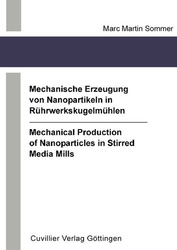| Areas | |
|---|---|
| Serie de libros (96) |
1378
|
| Nachhaltigkeit |
3
|
| Gesundheitswesen |
1
|
| Letra |
2363
|
| Ciencias Naturales |
5406
|
| Ciencias Ingeniería |
1791
|
| Ingeniería | 292 |
| Ingeniería mecánica y de proceso | 861 |
| Ingeniería eléctrica | 686 |
| Mineria y metalurgía | 30 |
| Arquitectura e ingeniería civil | 75 |
| General |
98
|
|
Leitlinien Unfallchirurgie
5. Auflage bestellen |
|
Erweiterte Suche
Mechanical Production of Nanoparticles in Stirred Media Mills (Tienda española)
Marc Martin Sommer (Autor)Previo
Indice, Datei (53 KB)
Lectura de prueba, Datei (350 KB)
Nanotechnology applications in the pharmaceutical, materials, and chemical industries has renewed interest in the use of wet grinding in stirred media mills for the production of nanoparticles with controlled microstructure. Quite recently it is possible to mill particles down to the size range of 10 nm.
However, challenges arise in the production of sub-micron particles that are, in part, due to colloidal surface forces influencing slurry stability and rheology. In this work experiments are performed on a well characterized model system of monodisperse primary nanoparticles that are salt destabilized and aggregated under various milling conditions. Perikinetic and orthokinetic aggregation are measured, with the latter in a laminar shear flow as well as in a stirred media mill, to examine the effects of colloidal stability and flow on the aggregation process. The agglomeration kinetics are measured using dynamic light scattering (DLS) as a function of electrolyte concentrations. Further information on the agglomeration process and the structure of the agglomerates are also obtained from small angle neutron scattering (SANS) and rheo-optical light scattering (ROA) experiments both at rest and under flow. Theoretical predictions for the colloidal stability from independently measured particle and solution properties compare well with the experimental results. Orthokinetic aggregation is observed to result in faster aggregation and denser agglomerates. Because of the high industrial demand for nanoparticles in organic media the study was extended to non-aqueous systems. Electrostatic stabilization requires a sufficiently high surface charge leading to a steeply decaying surface potential. These conditions can be met by solvents of medium dielectric constant (i.e. values larger than about 15-20), e.g. alcohols. In these media the particles may carry a high surface charge and the solubility of salts will be sufficient to enable a high repulsive barrier. It is shown that stable suspensions with high ζ-potentials can be achieved for alumina in ethanol with elecrostatic stabilization. Milling studies with electrostatic stabilization showed that the size of the primary particles is conspicuously smaller than the size of the particles milled under the same conditions in the aqueous phase. However, the media wear has a negative influence on the stability of the suspension since the ionic strengths in organic solvents are much lower. Milling experiments with steric stabilization in organic solvents produced larger primary particle sizes than with electrostatic conditions. The polymer layer around the particles seems to adsorb part of the grinding energy during the impact of two grinding beads and cushions the comminution. However, media wear has in contrast to the electrostatic stabilized particles in organic solvents no influence on the stability of the suspension. An important question is whether the mechano-chemical activation which was observed in aqueous media is crucial to obtain nanoparticles. Differential Scanning Calorimetry (DSC) and X-ray diffraction (XRD) measurements showed no mechano-chemical changes during milling in ethanol and toluene. In the aqueous phase the stabilization mechanism has no influence on the amount of hydroxide phase. A protecting polymer cover around the particles does not prevent the mechano-chemical changes.
| ISBN-10 (Impresion) | 3867272557 |
| ISBN-13 (Impresion) | 9783867272551 |
| ISBN-13 (E-Book) | 9783736922556 |
| Formato | A5 |
| Idioma | Inglés |
| Numero de paginas | 210 |
| Edicion | 1 |
| Volumen | 0 |
| Lugar de publicacion | Göttingen |
| Lugar de la disertacion | Erlangen-Nürnberg |
| Fecha de publicacion | 13.06.2007 |
| Clasificacion simple | Tesis doctoral |
| Area |
Ingeniería mecánica y de proceso
|








